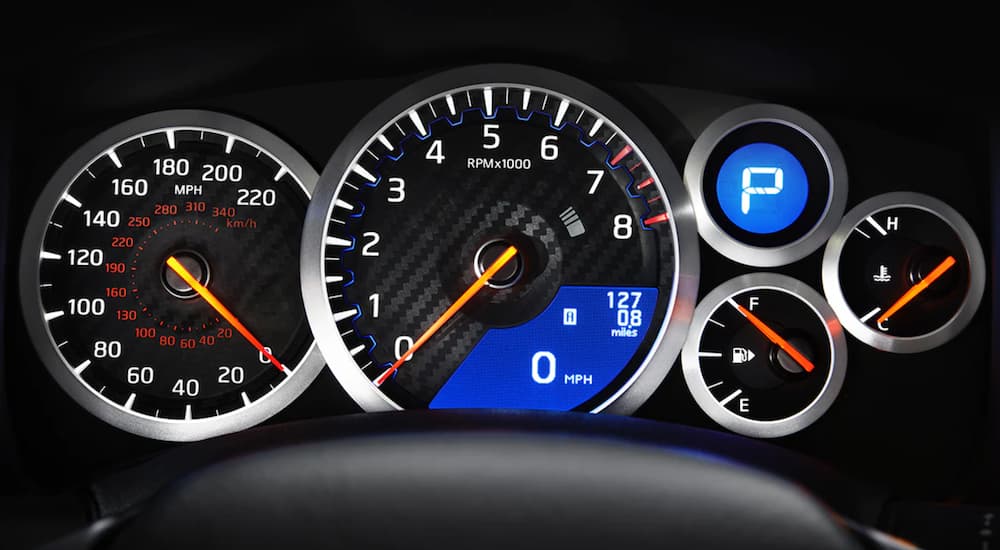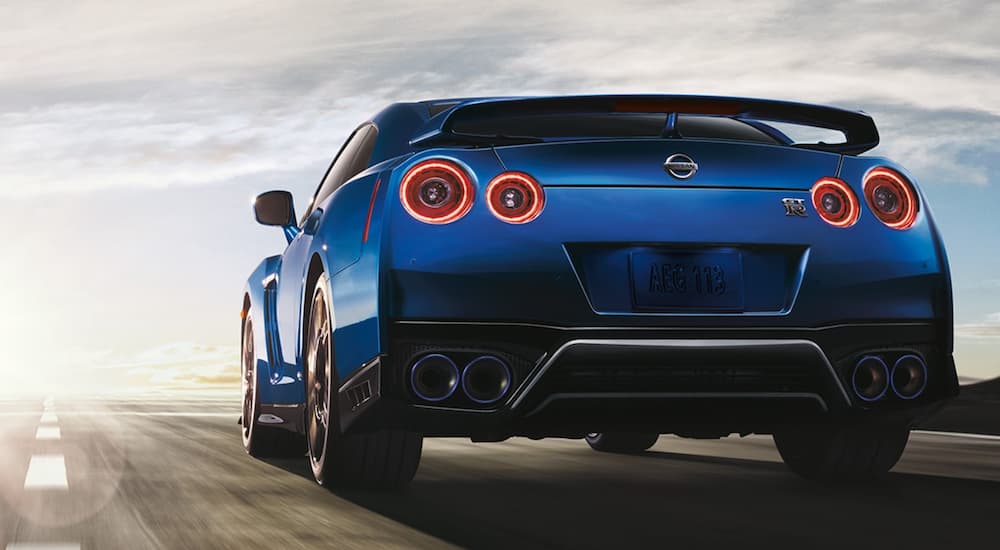Over the years, Nissan has been reshaping and sculpting its high-performance flagship, the Nissan GT-R. Unveiled in 2007 as the spiritual successor to the iconic Nissan Skyline GT-R, this supercar has been on the market for well over a decade years now, but it is far from out of date. Over the years, Nissan has continuously refined its high-performance touring car with changes that have kept enthusiasts going back to their local Nissan dealer to find out how to get their hands on the GT-R.
With all the tweaks and improvements that Nissan has made to the GT-R over the years, it can be difficult to narrow down the most important upgrades. However, we have done our best to choose just 5 of the landmark changes that have helped keep the GT-R up to date and interesting even after so long.
#5 – 45th Anniversary Gold Edition
In some ways, there’s little or no explanation needed for this. It’s exactly what it sounds like… a gold version of Nissan’s GT-R supercar to celebrate the 45th anniversary of the original Nissan Skyline GT-R. It literally gives drivers a vehicle encompassed in a gold livery, with matching gold brake calipers. The design of the vehicle absolutely stands out from the rest of the line-up thanks to its unique look and limited edition availability. In fact, only 30 or so gold GT-Rs were to make their way to American shores.
The 45th Anniversary Gold Edition of the Nissan GT-R was specially designed for the 2016 model year. So this wasn’t something you could get your hands on at just anytime or anywhere. It likely came as a surprise to fans of the supercar lovingly referred to as Godzilla. And even though the special edition didn’t actually change the overall performance of the GT-R, it is a unique and very distinctive aesthetic for Nissan’s supercar. As a collector’s item, it certainly would stand out among any car collector’s stash of rare vehicles.

#4 – 2014 Track Edition
The 45 Anniversary Gold Edition may have been a one-off for the 2016 model year, but the 2014 Track Edition ended up becoming a staple feature for the GT-R for the years that followed. The Track Edition wasn’t just another name for the same vehicle. This specific trim was designed to give owners of the GT-R a more track-ready experience, hence the name. There were a number of features added to this version of the GT-R that made it stand out in more than one way.
Even back in 2014, the introduction of the Track Edition was marked by some neat additions, such as carbon fiber spoilers and body details for improved aerodynamic performance. In the actual on-track performance tests, there were some impressive numbers that the GT-R Track Edition produced, such as improved braking, improved grip, and an impressive 0-to-60 launch time of 2.9 seconds. Improved springs and finely-tuned Bilstein shocks, not to mention lower weight thanks to jettisoning the rear seats and adding forged RAYS wheels, all add to the Track Edition’s on-track performance and handling. The continued existence of the Track Edition shows just how valuable this particular trim has been in adding more performance and handling options to the GT-R’s line-up.
#3 – 2017 Model Year Restyling
You might not remember it, but the Nissan GT-R wasn’t always as aesthetically pleasing as the more recent model years. Today, you can look at the GT-R and relish its stylish exterior. However, there were some growing pains the supercar went through before finally achieving its now-iconic look. A lot of that came from small, incremental adjustments to the fascia and lines over the years to keep refining the look to what we finally see today.
The biggest improvement actually came from the 2017 visual overhaul, which completely ditched the mid-tier sports car look from the previous years, and adopted a far more aggressive and modern appearance. Some of the changes came in the form of a more angular fascia, with a widened grille for improved air intake. A matching black mesh just under the LED lights looks like fangs under the headlights, giving the refreshed GT-R the guise of an apex predator out on the hunt.
The headlights were given a slight tweak, curving out and around the front fenders with a more accented look. The front fenders were also made to connect to the front air dam. These rather drastic visual changes to the exterior weren’t just done to retool the look of the GT-R but to improve the aerodynamics of the car as well. It worked as a two-fold purpose and has really helped keep the GT-R going strong through all these years.
#2 – Horsepower Upgrades
In the world of high-performance supercars and specialty sports vehicles, pushing the boundaries is imperative. Heck, constantly finding new ways to fine-tune the performance and either improve it or refine it are a large part of what makes them worth the price of entry for new model years. For the GT-R, Nissan has consistently upped the performance of the powerful twin-turbo 3.8L V6 engine hidden under the hood.
When first introduced in 2007, the GT-R provided 480 horsepower and 430 pound-feet of torque. Those were some heady numbers 15 years ago, but today that is about what a Ford Mustang GT is putting down. Fortunately, the GT-R has more than kept up with the competition, and the 2021 GT-R is now producing an incredible 600 horsepower and 481 pound-feet of torque. With a full 25% increase in power output, it can be difficult to believe this is the same car, but the all-wheel drive system in the GT-R is more than capable of handling all that extra muscle.
#1 – GT-R NISMO
The introduction of the GT-R NISMO production car was probably the most significant change, update, and upgrade that the GT-R has received over the years. NISMO stands for the Nissan Motorsports International performance arm of Nissan. It focuses on the motorsports aspects of the automaker, which has helped keep Nissan fresh in the minds of those who regularly consume content involving everything from Le Mans to touring car championships. If you see NISMO badged on a vehicle, then you know it’s tuned to tear up the track.
Back in 2013, Nissan officially christened the production version of the GT-R NISMO after having the GT-R NISMO compete in motorsports for several years prior. It wasn’t just about having a NISMO production trim made available for their supercar; it was about proving that the GT-R could compete with the very best of them. They accomplished this goal by setting a Nürburgring record back in 2013 with the production iteration of the GT-R NISMO trim. This was basically throwing down the gauntlet to other production supercars. Nissan wanted to show that they were serious not just about chasing gold on the track with specially modified GT-R racing models but also setting new standards on the street with a production vehicle that has the heart of a racing machine.
The improvement of the GT-R’s suspension, braking, power output, and performance thanks to the NISMO trim would help reshape the GT-R’s role on the market for future model years. It takes a lot to keep any vehicle feeling fresh after over a decade, let alone a high-performance supercar. A lot of Nissan’s success is thanks to the NISMO trim pushing the GT-R further than it’s ever been pushed.





